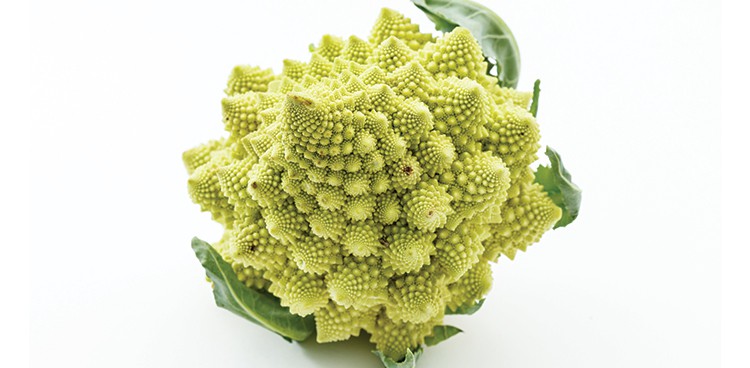
Once described by food author Elizabeth Schneider as “part starfish, part wedding cake,” Romanesco broccoli is as stunning as it is delicious. Hailing from Italy, cavolo broccolo romanesco – as it’s known in its homeland – has been around since the 16th century. Like other members of the brassica genus, it stemmed from wild cabbage before being domesticated and bred into the psychedelic-looking veggie we know today. Despite its name, the plant is actually more closely related to cauliflower than to standard broccoli. And like cauliflower, some varieties even have a purple tinge, though the bright green versions are much more common.
Andrea Yoder, co-owner and assistant operations manager of Harmony Valley Farm in Viroqua, Wis., grows about 10,000 heads of Romanesco per year. Her certified-organic farm has cultivated the otherworldly cruciferous vegetable for more than 20 years, and distributes it in CSA boxes. “We have 30 weeks of deliveries, so … we are always looking for interesting vegetables to keep things exciting – different flavors, different textures, different colors,” Yoder says.
Romanesco grows on a large, leafy plant, and the part that we eat is actually the flower. The harvest season for a colder climate is usually September to November. As Yoder explains, “Romanesco grows best when it starts to get cool. As with a lot of different brassicas, it sweetens after it’s had a light frost.” When the “wrapper leaves” surrounding the vegetable start to unfurl and recede, the Romanesco is harvested by hand.
To pick a good head of Romanesco, Yoder suggests looking at the development of the florets, which should be packed in a tight spiral and bright green in color. Ideally, you want Romanesco that “looks fresh, is crispy, and isn’t spongy or floppy,” she says. You can expect it to last seven to 10 days when stored in a loose plastic bag and kept in the crisper drawer of your refrigerator.
To cook Romanesco, Yoder recommends coating it with sunflower oil, salt, and pepper and popping it in the oven until it’s tender and “a little bit golden.” Roast it whole for a dramatic presentation, or divide it into smaller florets for a quicker cook time. Once it’s finished, Yoder likes to top hers with blue cheese, sharp cheddar, or aged gouda.
“When you roast it, it gets a nutty flavor,” which the cheese complements, Yoder says. Steamed Romanesco also makes an unexpected dipper for Classic Swiss Fondue or a tasty main dish when sautéed with rosemary and red pepper flakes and served atop pasta thickened with ricotta.




